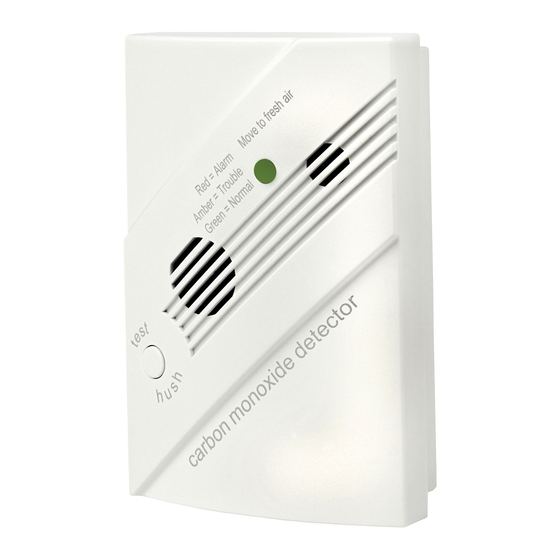
Table of Contents
Advertisement
Quick Links
260-CO SafeAir Carbon Monoxide Detector
Installation Sheet
Carbon monoxide alarm procedure
WARNING:
The carbon monoxide (CO) alarm indicates the
presence of CO, which can kill you. If the alarm signal sounds
four times, pauses for five seconds, and then repeats the
pattern:
1.
Press the Test/Hush button at the detector or at the
control panel.
2.
Move to fresh air immediately — outdoors or by an open
door or window. Check that all persons are accounted for.
Do not reenter the premises or move away from the open
door or window until emergency services responders have
arrived, the premises have been aired out, and your
detector remains in normal condition.
3.
Call emergency services, the fire department, or 911:
Phone:
4.
After following steps 1 to 3, if your detector reactivates,
repeat steps 1 to 3 and call a qualified appliance
technician to check for sources of CO from fuel-burning
equipment and appliances, and to inspect for proper
operation of this equipment.
Phone:
5.
If problems are found during this inspection, have the
equipment serviced immediately. Note any combustion
equipment not inspected by the technician and consult the
manufacturer directly for more information about CO
safety for the equipment. Make sure that motor vehicles
are not, and have not been operating in an attached
garage or adjacent to the premises.
© 2012 UTC Fire & Security. All rights reserved.
Information about carbon monoxide
WARNINGS
•
Read these installation instructions in their entirety before
proceeding. Leave these instructions with the owner/user
of this CO detection equipment.
•
This product is intended for use in indoor locations of
dwelling units. It is not designed to comply with
Occupational Safety and Health Administration (OSHA)
commercial or industrial standards.
•
The detector only indicates the presence of CO gas at the
detector. Carbon monoxide gas may be present in other
areas.
•
Failure to properly install, test, and maintain a CO detector
may cause it to fail, potentially resulting in loss of life.
•
Installation of this detector is not a substitute for proper
installation, use, and maintenance of fossil fuel-burning
appliances, including appropriate ventilation and exhaust
systems.
•
To reduce the risk of CO poisoning, test the detector
operation when not in use for 10 days or more.
•
This detector does not operate without electrical power. As
fires frequently cause power interruption, discuss further
safeguards with the authority having jurisdiction (AHJ).
•
Do not paint the detector.
Notes
•
Regulatory code may require that the system generate a
three-pulse temporal code (TC3) for fire alarms and a four-
pulse temporal code (TC4) for CO alarms.
•
The CO sensor is calibrated at the factory. CO sensitivity
is set to conform to UL 2034 requirements and cannot be
changed by the user. See "Specifications" on page 7 for
specific sensitivity values.
•
To reduce the likelihood of nuisance alarms, ventilate
accommodation spaces when using household cleaning
supplies or similar contaminants. If a detector has been
exposed to such contaminants, test it promptly afterwards.
Symptoms of CO poisoning
The following symptoms related to CO poisoning should be
discussed with all occupants of the protected site.
1 / 8
P/N 3102002-EN • REV 01 • ISS 27AUG12
Advertisement
Table of Contents

Subscribe to Our Youtube Channel
Summary of Contents for ESL 260-CO
- Page 1 260-CO SafeAir Carbon Monoxide Detector Installation Sheet Information about carbon monoxide WARNINGS • Read these installation instructions in their entirety before proceeding. Leave these instructions with the owner/user of this CO detection equipment. • This product is intended for use in indoor locations of dwelling units.
- Page 2 (AHJ). effects of CO exposure. It will not fully safeguard individuals The 260-CO detector meets UL 2075 Standard for Gas and with specific medical conditions. People with special medical Vapor Detectors and Sensors. It does not detect fire, smoke, or problems should consider using specialized detection devices any other gases.
- Page 3 • Near air conditioners, heating registers, or any other The 260-CO detector can connect to either UL 985 (Household ventilation source that may interfere with CO gas entering Fire Warning) or UL 864 (Commercial Fire) control panels. It is...
- Page 4 The 260-CO detector has an optional adapter mounting plate. Use the 250-COPLT adapter plate when replacing a 240-COe with a 260-CO to cover the footprint of the 240-COe. To (1) Trouble relay and power wiring hole purchase the plate, order P/N 250-COPLT-5PKG.
- Page 5 Only the initiating detector (1) End-of-line device (supplied by life safety system) (2) ESL 405-03 (12 VDC) or ESL 405-01 (24 VDC) polarity reversal will sound and blink red. All others in tandem mode will sound module but not blink red.
- Page 6 (1) End-of-line device (supplied by life safety system) detector and verify that the common trouble relay opens. (2) ESL 405-03 (12 VDC) or ESL 405-01 (24 VDC) polarity reversal Verify that the control panel reacts correctly to the relay module (3) Control panel activation.
- Page 7 [1] Use the UL Certified “Solo C6” canned CO product from SDi carbon monoxide electrochemical sensor. Replace the detector with a new 260-CO detector after 10 years from the date of To test the buzzer: manufacture (found on the product label on the back of the detector) or when the control panel goes into trouble and an Momentarily press the test/hush button.
- Page 8 Regulatory information Manufacturer Edwards, A Division of UTC Fire & Security Americas Corporation, Inc. 8985 Town Center Parkway, Bradenton, FL 34202, USA Year of The first two digits of the DATE MFG number manufacture (located on the product identification label) are the year of manufacture.


Need help?
Do you have a question about the 260-CO and is the answer not in the manual?
Questions and answers